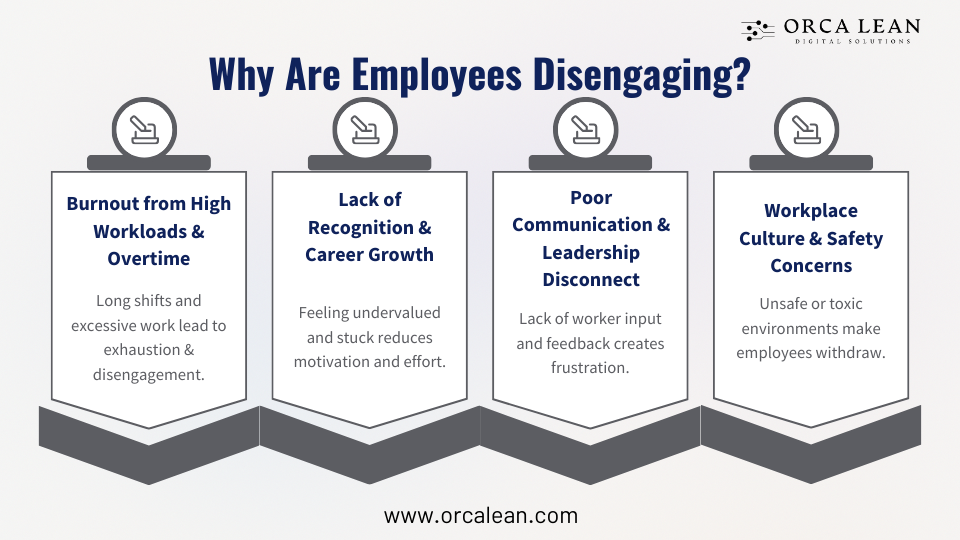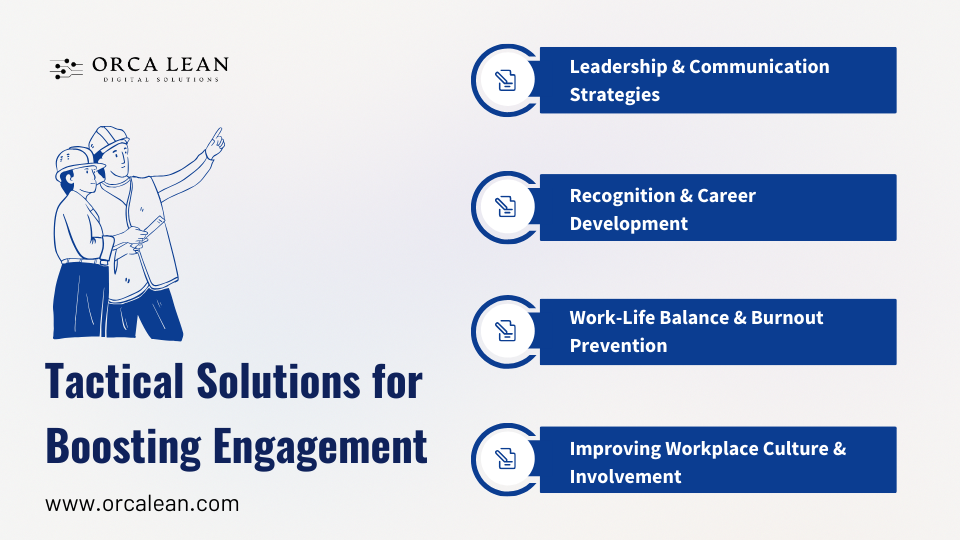
Executive & Strategy
FactoryKPI Executive
KPI Dashboard with Multi-plant analytics and comparisons
Problem Solving
SolvoNext-PDCA
A Smarter Problem Solving and Project Management Software based on deming and Toyota's PDCA - Plan, Do, Check, Act Method.
Qualitygram
A Unique Mobile and Web Software that helps Manage and Solve Problems Faster with Improved Team Communication.
SolvoNext-NCR CAPA
Digitize your NCR & CAPA process and Reduce Cost of Poor Quality (COPQ).

Why Employees Are ‘Quiet Quitting’ on the Factory Floor—And What You Can Do About It?
March 11, 2025
"Quiet quitting" isn’t about employees physically leaving their jobs—it’s about mentally checking out. On the factory floor, this manifests as workers doing only the bare minimum, disengaging from problem-solving, and losing motivation. While it may seem subtle, quiet quitting has serious consequences: reduced productivity, increased absenteeism, and a decline in continuous improvement efforts. In a manufacturing setting, this disengagement can lead to costly inefficiencies, quality issues, and high turnover rates.
To prevent silent attrition, manufacturers must understand why workers disengage and implement strategies to boost morale and retention. This article explores the root causes of quiet quitting and offers tactical solutions to re-engage employees.
Understanding Quiet Quitting in Manufacturing
Quiet quitting occurs when employees disengage from their work without officially resigning. In manufacturing, this might look like a skilled machine operator who once took initiative in troubleshooting issues but now simply waits for instructions.

But how do you identify quiet quitting? Here are some signs:
- Decline in proactive problem-solving – Employees stop making efficiency suggestions or troubleshooting minor issues.
- Reduced willingness to go beyond basic job duties – Tasks are completed at the minimum standard with no extra effort.
- Increased absenteeism or tardiness – Frequent lateness or unplanned absences indicate a lack of motivation.
- Lack of participation in improvement initiatives – Employees disengage from lean, continuous improvement, or Kaizen efforts.
The Root Causes: Why Are Employees Disengaging?
Quiet quitting stems from various workplace issues that erode motivation and job satisfaction. Here’s why employees disengage:

Burnout from High Workloads & Overtime
Many factories run on tight schedules, often requiring overtime to meet production targets. The physical demands of long shifts, repetitive tasks, and high-pressure work environments lead to exhaustion. When employees are consistently overworked without adequate recovery time, they disengage to cope with burnout, reducing their effort and enthusiasm.
Lack of Recognition and Career Growth
Feeling invisible or undervalued is a major driver of disengagement. Factory workers who put in effort but receive little appreciation may stop trying. Additionally, limited career growth opportunities make employees feel stuck. Without a clear path for advancement—such as promotions, training, or skill development—they lose motivation and perform only the bare minimum.
Poor Communication & Leadership Disconnect
Many factory workers feel that leadership makes decisions without their input. When management imposes directives without listening to workers’ concerns or feedback, employees feel unheard and undervalued. A lack of regular communication, feedback loops, or participatory leadership leads to frustration and disengagement.
Workplace Culture & Safety Concerns
A toxic or unsafe work environment erodes employee morale. If workers feel unsafe—whether due to inadequate safety measures, lack of training, or a culture of blame—they disengage as a protective mechanism. Psychological safety is equally important; employees who fear retaliation for speaking up will withdraw rather than engage.
The Business Impact of Silent Attrition
Ignoring quiet quitting has tangible business consequences:
Productivity Loss & Quality Issues
Disengaged employees are less likely to take initiative in problem-solving, leading to inefficiencies, delays, and increased defect rates. Lower motivation means less attention to detail, impacting product quality.
Rising Absenteeism & Turnover
When employees lose motivation, absenteeism rises, causing labor shortages and operational disruptions. High disengagement eventually leads to turnover, forcing companies to spend more on recruitment and training, further straining resources.
Decline in Continuous Improvement Initiatives
A lack of employee engagement hampers lean manufacturing and CI efforts. Workers who are disengaged are unlikely to participate in Kaizen events, Six Sigma projects, or process optimization initiatives, slowing down innovation and efficiency improvements.
Tactical Solutions for Boosting Engagement
To combat quiet quitting, manufacturers need targeted strategies that foster engagement and motivation.

A. Leadership & Communication Strategies
Managers must build trust through active listening and clear communication.
- Train supervisors on empathy and engagement—Employees respond better to leaders who listen and support them.
- Establish open-door policies and regular check-ins—Frequent one-on-one discussions show employees that their concerns matter.
- Implement structured feedback loops—Gemba walks, town halls, and anonymous surveys can help capture real concerns and solutions from workers.
B. Recognition & Career Development
A strong recognition culture and growth opportunities drive engagement.
- Launch an employee recognition program—Celebrate outstanding performance with bonuses, shout-outs, or employee-of-the-month awards.
- Offer cross-training opportunities—Allow workers to develop new skills, reducing monotony and improving versatility.
- Provide education reimbursement or skill certifications—This investment makes employees feel valued and increases retention.
C. Work-Life Balance & Burnout Prevention
Manufacturers must create sustainable workloads to prevent burnout.
- Introduce flexible scheduling where possible—Rotating shifts or adjusted work hours can improve work-life balance.
- Address excessive overtime—Monitor workloads to prevent overburdening employees.
- Implement wellness programs—Providing access to mental health resources, physical therapy, or ergonomic improvements can reduce stress.
D. Improving Workplace Culture & Involvement
A positive workplace culture encourages engagement and participation.
- Encourage team-based problem-solving—Engage workers in Kaizen events and lean manufacturing improvements.
- Develop mentorship programs—Pairing experienced workers with new hires fosters teamwork and a sense of belonging.
- Ensure workplace safety—both physical and psychological—A safe environment fosters confidence and engagement.
Measuring Success & Continuous Improvement
To ensure engagement efforts are effective, manufacturers must track key metrics and refine strategies.
Key Metrics to Monitor:
- Turnover rates – A spike in voluntary exits signals disengagement.
- Absenteeism rates – Frequent unplanned absences indicate employee dissatisfaction.
- Productivity levels – Declining efficiency or increased errors may point to disengagement.
- Employee feedback scores – Regular pulse surveys help gauge morale and engagement levels.
How to Improve Continuously:
- Regular pulse surveys – Short, frequent check-ins help identify issues early.
- Act on employee feedback – When workers see their concerns addressed, engagement improves.
- Iterate engagement strategies – What works today may not work tomorrow; consistently refine approaches based on real-time input.
By making engagement a core operational priority, manufacturers can prevent quiet quitting and cultivate a more motivated workforce.

Conclusion
Quiet quitting on the factory floor is a silent but serious issue that impacts productivity, quality, and retention. By addressing burnout, improving communication, recognizing employees, and fostering a positive workplace culture, manufacturers can re-engage their workforce and reduce silent attrition.
To create a long-term solution, manufacturers must go beyond reactive fixes and integrate digital tools that track engagement, improve communication, and streamline employee feedback. Investing in workforce analytics and digital engagement platforms can help leaders make data-driven decisions and proactively enhance employee satisfaction.
Start making small changes today—your employees (and your bottom line) will thank you.

Software Solutions for Manufacturing Excellence
Company
Social
Our Contact Info:
Email: contact@orcalean.com
Phone Number: 248 938 0375
Our Offices